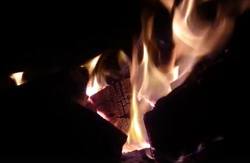 So my focus is more on friction fire (and stories\rituals\sacredness etc) than bushcraft but I thought I would write a bit on firewood, as once you've tempted that ember out of the wood, you need to be able to feed that ember and feed the fire. It is good to understand the properties of wood and which ones are good for burning, especially outdoors in the wild (which is slightly different to home especially if you use a wood burner.) The best kindling wood, is wood which burns easily and fast, and best fire wood is wood which is usually denser, burns more slowly, doesn’t spark\smoke and gives good heat output. Here are a few different types of wood you may find in UK woodlands, and burning properties. And of course woods burn best when dry, have had chance to season (not green) and not punky (however very dry punky wood can be good for tinder.) Look for dead standing (vertical) wood, as it will be drier (water runs off it), or wood which has been off the ground. Wood on the ground will be damper. Also, just because a wood is good for creating embers through friction it doesn’t mean it’s a good burning wood! Typically the best woods for friction fire are poor for burning and good burning woods are poor for friction - with exceptions e.g. Hazel and Ash work for both.. Also, it's essential to know your trees (a good pocket guide is very useful.) Kindling: Wood which burns easily and quickly is best for kindling and should be split very thin to start then add increasingly bigger pieces until fire is burning well. E.g. Hazel, Ash, Beech, Hazel, Hawthorn. Pine works well too for kindling. I usually use the tipi fire lay method. Firewood: Split wood usually burns better than big logs, and start with smaller (in thickness) sized pieces and gradually add bigger pieces. Recommended for open fires: Ash: Reckoned by many to be one of best woods for burning. It produces a steady flame and good heat output. It can be burnt when still green but like all woods, it burns best when dry. (Ash also works well for friction hearth boards.) Hazel: Is a good fast burning wood with little spitting and good for starting your fire. (Hazel is my favourite for friction spindles and also hearth boards when used with itself.) Hawthorn: Is a good traditional firewood that has a slow burn with good heat output and little smoke. (Good for bearing blocks as very hard.) Blackthorn: Another good wood. Burns slowly with lots of heat and little smoke. (Good for bearing blocks as very hard.) Beech: Burns very much like ash, but does not burn well when green. Has a tendency to spark. Hornbeam: A good burning wood that burns similar to beech, slow burn with a good heat output. Yew: A good burning wood as it has a slow burn, and produces a very good heat output. Rowan: A good burning wood as it has a slow burn, and produces a very good heat output. Some people prefer not to burn Rowan due to personal beliefs (it being seen as a sacred wood.) Birch: Is a very good burning wood although burns fairly fast. Mix with slower burning woods Not really reccomended for open fires Oak: Good firewood for home when seasoned but can be poor for outdoor fires. Because of its density, oak produces a small flame and very slow burn, it is best when seasoned for a minimum of two years as it is a wood that requires time to season well (so may be hard to find good well seasoned dry oak in the wild!) Due to it’s sacredness Oak tended to be used in ritual\ceremonial fires within the UK. Sycamore: Produces a good flame, but with only moderate heat output. Should only be used well-seasoned. (Good for friction fire – it’s one I’ve not tried yet) Pine - Burns well but tends to spit. The resinous wood makes good kindling so better for kindling rather than firewood. (works for friction fire – another one I’ve not tried yet) Ivy – dry and well seasoned it is supposed to burn well according to some, but in the wild can be difficult finding dry well seasoned ivy. Very good for friction hearth boards. Alder: Produces poor heat output and it does not last well. Douglas fir: Not very good. Produces little flame or heat. Poplar: A very smokey wood with a poor burn. Good for friction fire (one I’ve not tried yet.) Willow: A poor fire wood that does not burn well even when seasoned. Good for for friction hearth boards and spindles. Larch: Needs to be seasoned well. Spits excessively while it burns. Elder: Burns quickly with little heat. Very smokey. (Very good for hand drill spindles)
Elm: Typically poor for open fires as it needs to have been seasoned for a couple of years and is slow to get going Holly: Is a fast burning wood that produces good flame but poor heat output. Holly will burn green, but best dried for a minimum of a year. Horse&Sweet Chestnut: A good wood for burning in wood stoves but not for open fires as it does tend to spit a lot. It does however produce a good flame and heat output. Spruce - Burns very quickly and sparks badly. Laurel: Said to be good firewood but best stay away from Cherry Laurel as leves contains cyanide. Conflicting opinions on whether you can burn it – some say if split and well seasoned then apparently you are ok. Seen other stories of people getting headaches from it. I would say stay away from it – there’s plenty of other wood Lime: Not a good wood for burning as it produces very little flame or heat output. Very good for friction hearth boards. Comments are closed.
|
Archives
January 2024
Categories
All
|
 RSS Feed
RSS Feed